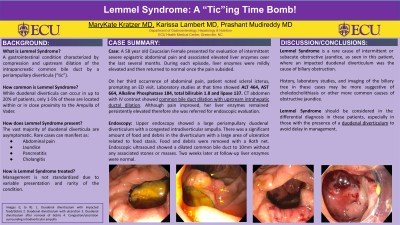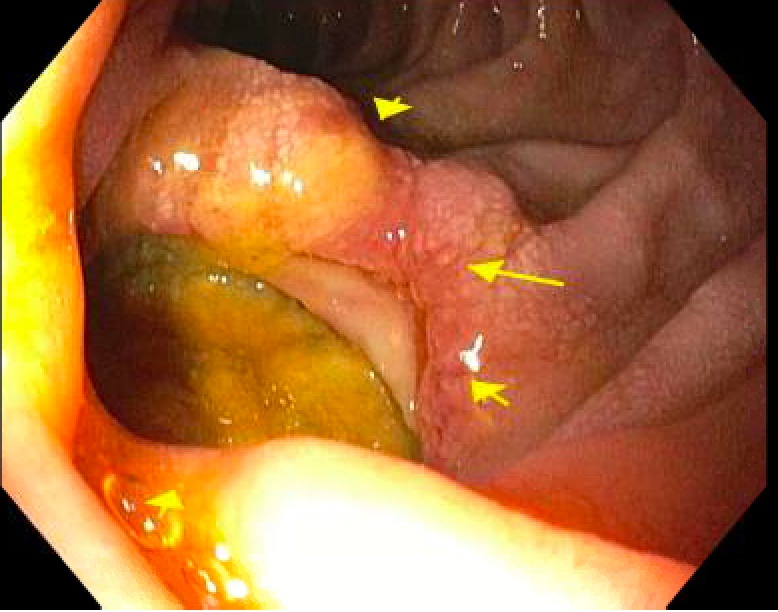Sunday Poster Session
Category: Biliary/Pancreas
P0103 - Lemmel Syndrome: A “Tic”ing Time Bomb!
Sunday, October 27, 2024
3:30 PM - 7:00 PM ET
Location: Exhibit Hall E

Has Audio
- MK
MaryKate Kratzer, MD
East Carolina University Medical Center
Greenville, NC
Presenting Author(s)
MaryKate Kratzer, MD1, Christin Wilkinson, MD2, Karissa Lambert, MD3, Prashant Mudireddy, MD3
1East Carolina University Medical Center, Greenville, NC; 2East Carolina University, Greenville, NC; 3East Carolina Gastroenterology, Greenville, NC
Introduction: Lemmel syndrome is an uncommon gastrointestinal condition characterized by compression and upstream dilatation of the intrapancreatic common bile duct by a periampullary duodenal diverticulum. While duodenal diverticula can occur in about 20% of patients, only 1-5% of these are located within or in close proximity to the Ampulla of Vader. The vast majority of duodenal diverticula are asymptomatic, however rare cases manifest as abdominal pain, jaundice, pancreatitis, or cholangitis. Management of Lemmel syndrome is not standardized, due to variable presentation and rarity of the condition. We explain a unique case of Lemmel syndrome presenting as intermittent obstructive jaundice.
Case Description/Methods: A 58 year old female presented for evaluation of intermittent severe epigastric abdominal pain with associated elevated liver enzymes, which normalized with resolution of pain. During her third episode in 2 months, she developed scleral icterus, prompting her to go to the emergency department for evaluation. Laboratory studies at that time showed ALT of 464, AST of 664, total bilirubin 1.8, Alkaline Phosphatase 184, and Lipase 137. CT of the abdomen with IV contrast showed common bile duct dilation with upstream intrahepatic ductal dilation, as well as a large duodenal diverticulum containing fluid and particulate material near the papilla. Although her pain improved over the next several weeks, liver enzymes remained persistently elevated with a peak total bilirubin of 4.9, prompting consultation for endoscopic evaluation.
The patient underwent upper endoscopy which showed a large periampullary duodenal diverticulum with a congested intradiverticular ampulla. There was a significant amount of impacted food and debris in the diverticulum with a large area of ulceration related to food stasis. Food and debris was removed with a Roth net. Endoscopic ultrasound revealed a dilated common bile duct to 10mm without any associated stones or masses. Two weeks later at follow-up, liver enzymes were normal.
Discussion: Lemmel syndrome is a rare cause of intermittent or subacute obstructive jaundice, as seen in this patient, where an impacted duodenal diverticulum was the cause of biliary obstruction. While history, laboratory studies, and imaging of the biliary tree may be suggestive of choledocholithiasis or other more common causes of obstructive jaundice, Lemmel syndrome should be considered in those with the presence of a duodenal diverticulum to avoid delay in management.

Disclosures:
MaryKate Kratzer, MD1, Christin Wilkinson, MD2, Karissa Lambert, MD3, Prashant Mudireddy, MD3. P0103 - Lemmel Syndrome: A “Tic”ing Time Bomb!, ACG 2024 Annual Scientific Meeting Abstracts. Philadelphia, PA: American College of Gastroenterology.
1East Carolina University Medical Center, Greenville, NC; 2East Carolina University, Greenville, NC; 3East Carolina Gastroenterology, Greenville, NC
Introduction: Lemmel syndrome is an uncommon gastrointestinal condition characterized by compression and upstream dilatation of the intrapancreatic common bile duct by a periampullary duodenal diverticulum. While duodenal diverticula can occur in about 20% of patients, only 1-5% of these are located within or in close proximity to the Ampulla of Vader. The vast majority of duodenal diverticula are asymptomatic, however rare cases manifest as abdominal pain, jaundice, pancreatitis, or cholangitis. Management of Lemmel syndrome is not standardized, due to variable presentation and rarity of the condition. We explain a unique case of Lemmel syndrome presenting as intermittent obstructive jaundice.
Case Description/Methods: A 58 year old female presented for evaluation of intermittent severe epigastric abdominal pain with associated elevated liver enzymes, which normalized with resolution of pain. During her third episode in 2 months, she developed scleral icterus, prompting her to go to the emergency department for evaluation. Laboratory studies at that time showed ALT of 464, AST of 664, total bilirubin 1.8, Alkaline Phosphatase 184, and Lipase 137. CT of the abdomen with IV contrast showed common bile duct dilation with upstream intrahepatic ductal dilation, as well as a large duodenal diverticulum containing fluid and particulate material near the papilla. Although her pain improved over the next several weeks, liver enzymes remained persistently elevated with a peak total bilirubin of 4.9, prompting consultation for endoscopic evaluation.
The patient underwent upper endoscopy which showed a large periampullary duodenal diverticulum with a congested intradiverticular ampulla. There was a significant amount of impacted food and debris in the diverticulum with a large area of ulceration related to food stasis. Food and debris was removed with a Roth net. Endoscopic ultrasound revealed a dilated common bile duct to 10mm without any associated stones or masses. Two weeks later at follow-up, liver enzymes were normal.
Discussion: Lemmel syndrome is a rare cause of intermittent or subacute obstructive jaundice, as seen in this patient, where an impacted duodenal diverticulum was the cause of biliary obstruction. While history, laboratory studies, and imaging of the biliary tree may be suggestive of choledocholithiasis or other more common causes of obstructive jaundice, Lemmel syndrome should be considered in those with the presence of a duodenal diverticulum to avoid delay in management.

Figure: Impacted duodenal diverticulum with periampullary inflammation and ulceration
Disclosures:
MaryKate Kratzer indicated no relevant financial relationships.
Christin Wilkinson indicated no relevant financial relationships.
Karissa Lambert indicated no relevant financial relationships.
Prashant Mudireddy indicated no relevant financial relationships.
MaryKate Kratzer, MD1, Christin Wilkinson, MD2, Karissa Lambert, MD3, Prashant Mudireddy, MD3. P0103 - Lemmel Syndrome: A “Tic”ing Time Bomb!, ACG 2024 Annual Scientific Meeting Abstracts. Philadelphia, PA: American College of Gastroenterology.
